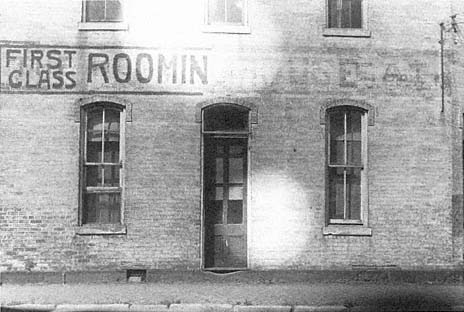Hotel Homes as a Public Nuisance
Like the reformers' ironic positions on real estate values, the negative hotel housing opinions voiced by literary critics, housing activists, health officials, and social workers were not without their internal contradictions and exceptions: hotel housing did not provide proper individuality and personal expression, yet it fostered selfish individualism; hotel housing was pathologically isolating, yet it was not sufficiently private; no one supposedly met anyone in hotels, yet lodging houses were meeting places of great danger. Outright hypocrisy characterized other critiques: amusements enjoyed by wealthy people (billiards for men after dinner; cotillions for all) were wrong in commercial settings or when enjoyed by wage laborers and families struggling to enter the middle and upper class. Some critiques were simply myopic: the people who saw the pathologies of rooming houses rarely mentioned the parallels in other housing types, such as the breaches of sexual mores at weekend house parties of the wealthy or elderly widows pathologically isolated in middle-income suburban houses.
A few social commentators did understand and accept the hotel population's nontraditional ways of living. The Chicago sociologist Day Monroe was one of these exceptions. In a study of Chicago families she noted that "certainly fewer than 20 percent" of the people living in hotels exemplified the supposed "social waste, unproductive leisure,

Figure 7.16
Rooming house in Lancaster, Ohio, 1938. As a photographer, Ben Shahn caught the
irony of a single worker's life-style labeled "first class."
or even family disorganization" that others automatically associated with hotel life. The majority of women living in hotels had good reasons for being there and represented social well-being, Monroe said.[91] Charles Swanson wrote his doctoral dissertation on the social backgrounds in Lower West Side districts of Manhattan, areas analogous to the Chicago rooming house area analyzed in Zorbaugh's Gold Coast and Slum . Swanson failed to find the social pathologies described by Zorbaugh. He saw "no area of anonymity, of desolation, loneliness, and lost personalities." He said that quite the contrary seemed to have been true, since Bohemianism strictly tabooed such qualities.[92]
Nonetheless, with such occasional exceptions, after 1890 the case for hotel life was rarely stated forcefully or officially. By the 1920s, the case against hotel housing options had successfully been assembled. Stated most simply, to its critics the continued existence of hotel life worked against the progress of the grand new city. In the biological analogies of the day, the residential hotel buildings themselves served as incubators of old-city pathologies. For the reformers working on the new city, single-room dwellings were not a housing resource but a public nuisance (fig. 7.16).
In 1910, Veiller published a major model housing law to help promote such legislation throughout the United States. For each section of the proposed law, he provided capsule explanations. In his explanation
for the definition of "tenement," Veiller was careful to emphasize the following point:
[The definition of tenement] does not include hotels nor lodging houses. It should not do so. [***] The problems of the common lodging house occupied by homeless men or homeless women are totally different from the problems of the tenement house occupied by families. The two should not be confused.[93]
The asterisks inserted in the quotation indicate an automatic leap in Veiller's mind, a leap made by virtually all reformers of his day. Any single-room life automatically meant the worst possible case, which Veiller castigated as the "common lodging house" filled with "homeless men and women." Writing to his audience of legislators, lawyers, and lobbyists, Veiller was careful to note in another section that activists could not legally label hotels and lodging houses as nuisances, since common law and the jurisprudence of the time recognized only sanitary or health problems as worthy of legal exclusion. Even the cheapest lodging house, when new, did not present the health problems that tuberculosis officers found in older ones. But Veiller clearly implied that hotel buildings were public nuisances. The wholesale adoption of Veiller's building codes in many states, including California, proved that reformers elsewhere agreed.
To someone watching the building of the city up to 1920, all the antihotel work of the Victorian and Progressive Era reformers might have seemed for naught. They had enunciated antihotel opinions but typically had not stopped new residential hotel construction or operation. Reformers had accomplished changes of rhetoric more than changes of action. In fact, the early 1920s were a boom period for hotel building and hotel living of most sorts. However, while the laws were not yet adequate to eradicate single-room homes, American law had begun to recognize residential hotels as a nuisance. The foundation of professional and public opinion encouraged by the Progressive Era reformers would serve to exclude the option of hotel homes in urban culture as developers rebuilt the old city of pre-World War I and expanded the new automobile suburbs. Housing action of the future would ensure new homes that were uniformly separate, sanitary, and (most of all) centrally approved.